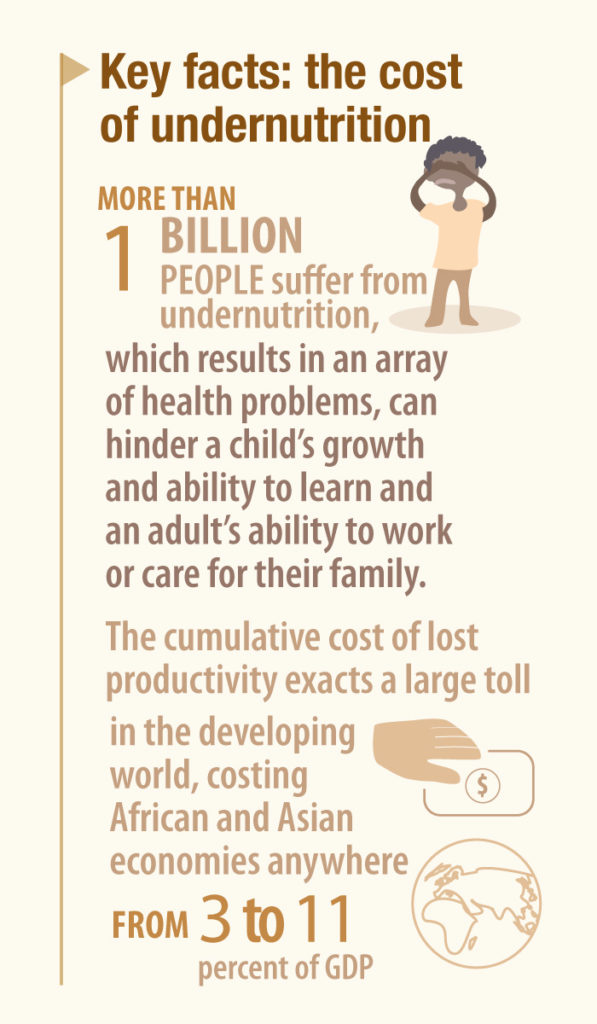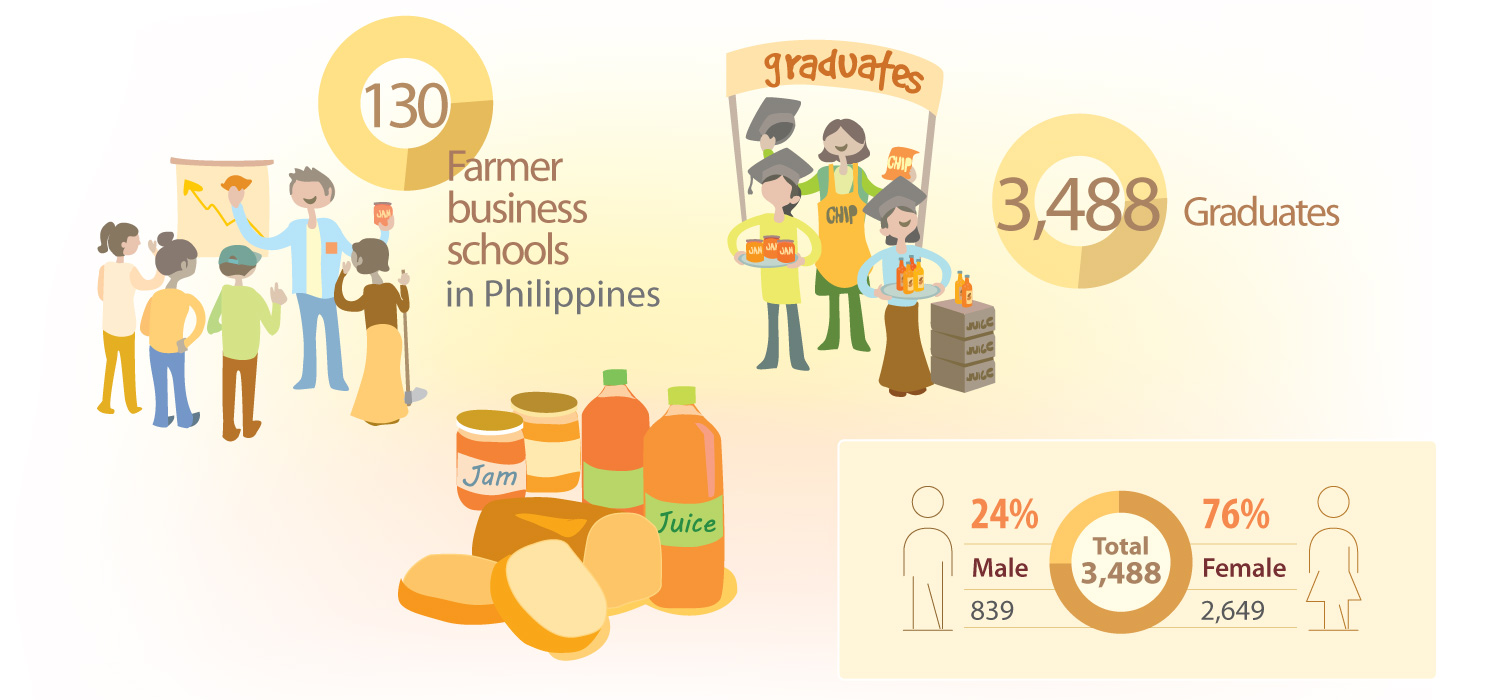Case for investment: Inclusive growth
Overview
- Potatoes and sweetpotatoes are valuable cash crops which can be grown in an array of environments affected by climate change, making them vital for reliable incomes, especially when grain crops fail.
- Development and dissemination of high-yielding, fast-maturing, resilient varieties leads to better, earlier harvests, opening up new livelihood opportunities.
- Training in best agronomic and postharvest practices helps men and women farmers tap those varieties’ full economic potential.
- Technologies to produce disease-free starting material and the development of seed systems to multiply and disseminate quality planting material catalyze equitable income opportunities.
- The versatility of potato and sweetpotato allows for the development of inclusive value chains such as the production of packaged foods for high-value markets.
- Gender-responsive market-chain approaches build farmers’ capacity to add value to their crops, reduce postharvest losses, and gain access to new markets.
- Nutritious biofortified varieties can also reduce the burden of malnutrition, boosting inclusive growth in the long run.
- Early maturing potato varieties that can be grown in the months between rice or wheat cropping cycles enable the sustainable intensification of farming to produce more food and income per hectare.
- Investment priorities include:
- Breeding and promoting more resilient, fast-maturing, market-valued crop varieties;
- Supporting the development of seed systems to supply farmers with quality planting material;
- Improving market access and facilitating the creation of new, inclusive value chains; and
- Providing training in production-enhancing techniques and farm diversification.
Introduction
Approximately 75% of the world’s poorest live in rural areas where agriculture is the main economic activity. In developing countries, agriculture can represent more than a third of a nation’s GDP. Globally, the agricultural sector provides incomes and livelihoods for two billion smallholders.
Potatoes and sweetpotatoes provide a reliable source of income in developing countries, particularly where climate extremes increasingly cause other crops to fail. More than one billion people eat them regularly, creating opportunities for gender-inclusive and equitable livelihoods for farmers, traders, food processors and others.
Breeding to improve the resilience of potato and sweetpotato can further contribute to productivity in a climate-changing
world. Interventions to expand the availability of quality seed of improved varieties result in higher yields and incomes, while supporting better health and broader economic activity.
The versatility of potatoes and sweetpotatoes means farmers can diversify their incomes. Given the many ways these crops can be prepared or processed, farmers who grow them have more options – they can sell their crop directly to formal or informal markets, or to food companies that produce breads, biscuits, etc. Such uses result in value chains that generate employment opportunities for men and women in rural and urban areas.
Enhancing the potential of potato and sweetpotato as cash crops can help sustain rural agricultural economies, reducing the need for people to migrate from areas where agriculture is no longer viable to urban areas where the only income option is often on the informal labor market.
Potatoes and sweetpotatoes can also support inclusive growth indirectly by helping to reduce undernutrition, which costs the global economy as much as USD 2 trillion annually in healthcare and lost productivity. Biofortified varieties contribute to improved nutritional outcomes, and healthier more productive citizens.
Building blocks
Value chain approaches
A participatory market approach (PMCA) has been used to enable farmers, traders, retailers and others to improve their incomes. It was originally developed to stimulate the creation of new markets and supply chains for native potatoes in the Andes region under a program that reached 100,000 smallholder men and women farmers and market agents, driving a 70% rise in sales of native potato products. PMCA has since been used in Africa and Asia for products that included banana, cassava and sweetpotato. Components of this approach were later adapted to facilitate entrepreneurship through a gender-responsive ‘farmer business school’ approach, which has been successfully used in several Asian countries.
Farmer business schools
To help smallholders access better markets, reduce the toll of postharvest loss, and improve incomes, CIP developed a ‘farmer business school’ (FBS) approach that consists of a series of group-based learning activities with trained facilitators over a production-marketing cycle (8–10 months). The approach empowers women and men farmers and encourages collaboration among farmers and with other value chain actors. Farmer groups undertake market assessments, develop, and launch their own products, adding value to traditional goods and boosting the economies of remote communities. CIP launched FBS in Indonesia in 2009 and subsequently took it to scale in India, Indonesia and the Philippines, mainly through partnerships with large-scale IFAD investment projects. In the Philippines, more than 130 farmer business schools were held and almost 3,500 smallholders graduated, 76% of them women.
Improved crop varieties
The development and dissemination of improved varieties has helped millions of farmers boost their production and incomes. Potato and sweetpotato yields in most developing countries are a fraction of what they could be, primarily because most farmers plant poor quality seed of older varieties. Many CIP-bred varieties are disease resistant, so they save farmers money that would otherwise be spent on agrochemicals or certified seed.
Better potatoes generating billions
More than 2.5 million farmers (direct beneficiaries, representing 20% of total beneficiaries) in the seven most important potato-producing Asian countries have adopted CIP-bred potato varieties with climate resilience and other preferred traits. Just one variety, C88 variety, was cultivated on an estimated 125,000 hectares in China’s Yunnan province generating an estimated USD 2.8—3.73 billion from 1996 and 2015.
Seed systems
The use of quality potato or sweetpotato planting material results in better yields, and as farmer demand for it grows, seed value chains are developed, creating entrepreneurial opportunities and employment for women and men. Studies have demonstrated that potato farmers who have used high-quality seed tubers can significantly increase their incomes from sales within relatively short timespans. CIP and national partners produce disease-free starter material of improved potato and sweetpotato varieties and sell it to seed multipliers, who use it to grow planting material for sale, earning a considerable profit. Farmers who multiply disease-free potato or sweetpotato planting material for sale to other farmers, or organizations, earn significantly more than those who simply grow those crops for consumption.
Quality seed boosts yields and incomes
CIP has partnered with Ethiopian government agencies to promote the production of quality declared seed potatoes, which produce higher yields than the pest- or pathogen-infected seed tubers that most Ethiopian potato farmers plant. Local partners have been provided with training in quality seed production, including technicians, at approximately 150 potato cooperatives, which purchased healthy starter material from the Ethiopian Institute of Agriculture Research and multiplied it for sale to farmers. This resulted in more than 200,000 Ethiopian farmers using quality seed potatoes. A study of 116 of those farmers and found that their yields were 63% higher than those of farmers who didn’t use quality seed.
Enhanced agronomic approaches
Agronomic training and appropriate technologies help farmers increase yields and reduce postharvest losses, both of which translate into more income. CIP has produced gender-responsive training manuals in local languages and organized sessions for thousands of extension agents and expert farmers, who have in turn shared best practices for improving potato and sweetpotato yields and shelf life with more than two million farmers globally. Training sessions usually accompany the distribution of planting material of improved varieties, enhancing their adoption and benefits. Appropriate technologies validated and disseminated through CIP interventions include integrated pest and disease management to reduce crop loss and dependence on expensive agrochemicals; diffuse light stores to conserve potatoes that will be used as seed or sold in the months following harvests, when prices are higher; and storage of sweetpotatoes in sand to extend their shelf life and produce quality planting material in time for the next growing season.
Sweetpotato value chains
CIP has promoted the use of sweetpotato in an array of food products, including juices, jams, biscuits and other baked products. Scientists in Nairobi developed a way to produce a shelf-stable sweetpotato puree that can be stored for several months without refrigeration, making a perishable crop more accessible to bakeries and other food businesses. Puree production and use by bakeries and other food companies has generated new jobs, many of which are held by women or young people. It has also resulted in higher demand and market prices for sweetpotatoes, boosting farmer incomes.
In Kenya and Rwanda alone, annual sales of sweetpotato puree-based products exceed USD 1 million. This has inspired a growing number of private sector investments in sweetpotato processing in Kenya, Malawi, Rwanda, South Africa, Tanzania and Uganda.
Sustainable intensification
The development of climate-smart, early maturing potato varieties that are ready to harvest fewer than 90 days after planting opens the door for sustainable intensification of farming. Those potatoes can be grown on land primarily used for rice or wheat in the months between cropping cycles. This allows farmers to produce more food, and earn more, on the same land. Heat tolerant potatoes have been grown in the lowlands of Tajikistan following the wheat harvest, when if is too hot for most crops. On the coast of Bangladesh, where cyclone storm surges turned soils saline, salt- and heat-tolerant varieties are grown in fallow paddies following the rice harvest. One study found that the sustainable intensification of rice-based systems with potato has huge potential for improving incomes in Bangladesh and India.
Sequential-cropping of potato and rice worth USD800 million
A growing selection of heat-tolerant, early maturing varieties are allowing rice and wheat farmers in Asia to add another crop into their farm systems, usually during a fallow period, which results in additional income and greater food availability. Several heat- and salt-tolerant varieties released in Bangladesh are being grown in coastal areas where farmland is often too saline for other crops. CIP expects to release iron- and zinc-rich biofortified potatoes in several Asian countries soon, helping further reduce malnutrition. Prospective economic welfare gains from sustainably intensifying rice-based food systems with early-maturing, climate-smart potatoes in Bangladesh are estimated at USD 800 million a year.



